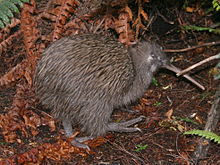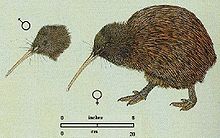- Southern Brown Kiwi
-
Southern Brown Kiwi 
Stewart Island Tokoeka Conservation status Scientific classification Kingdom: Animalia Phylum: Chordata Class: Aves Order: Apterygiformes Family: Apterygidae Genus: Apteryx Species: A. australis Binomial name Apteryx australis
(Shaw and Nodder, 1813)[2]Sub-species A a. lawryi (Rothschild, 1893)[3]
Stewart Island Tokoeka
A a. australis (Shaw and Nodder, 1813)[3]
Haast TokoekaThe Southern Brown Kiwi, Tokoeka, or Common kiwi,[2] Apteryx australis, is a species of kiwi from New Zealand's South Island. Until 2000 it was considered conspecific with the North Island Brown Kiwi, and still is by some authorities.
Contents
Taxonomy
Apteryx australis is based on Greek and Latin. Apteryx means "A-" without "pterux" wings, and "australis" from "auster" the south wind, and "-alis" relating to. Hence Relating to the south wind is the meaning of Australis, not Australia.[4] The Southern Brown Kiwi belongs to the Kiwi family and it is a ratite, and a member of the order Struthioniformes. Like all ratites, its sternum has no keel, it is flightless, and it has a distinctive palate.[2]
The Southern Brown Kiwi is divided into two subspecies:
- A. a. australis, South Island Brown Kiwi , with a population of approximately 7,000 birds is found on the South Island of New Zealand. A disjunct population, called the Haast Brown Kiwi is rare (with only about 250 specimens left) and is characterised by its rufous plumage[5]. The Haast Brown Kiwi is named for where it lives, Haast.
- A. a. lawryi, Stewart Island Brown Kiwi is relatively common (20,000 birds) throughout its range, with about 17 birds per square kilometre. Its feathers are streaked lengthwise with reddish-brown.[5]
Description
It has no preen gland, and its feathers have no aftershafts and no barbules. There are large vibrissae around its gape, and it has no tail, only a pygostyle. It has a length of 45–55 cm (18–22 in) and the female weighs 2.1–3.9 kg (4.6–8.6 lb) and the male weighs 1.6–2.8 kg (3.5–6.2 lb) Its bill is long and slender with a slight down-curve. Like other kiwis it is nocturnal. The color of its plumage is rufous with some streaking.[2]
Behavior
Vocalization
Southern Brown Kiwi communicate vocally to aid in defending their territory. They will also sing duets with each other, with the female shrill "kee-wee" or "kee-kee" and the males hoarse " kurr kurr". Males are more vocal and they both call in an upright position with their legs stretched out and their bill pointing up.[2]
Diet
The Southern Brown Kiwi has a long slender beak with lateral nostrils at the tip, which helps give them their keen sense of smell. They utilize this, more than sight and sound, to forage in dirt for invertebrates, including earthworms, beetle larvae, snails, spiders, centipedes, and orthoptera. Its gizzard is weak, and underutilized due to the lack of plant matter. Its caeca are long and narrow and aid in digestion.[2]
Reproduction
The Southern Brown Kiwi, like all kiwi, has two functioning ovaries, however only the left oviduct functions, allowing eggs from both ovaries to pass through. It is a monogamous species and once paired up, they will defend their territories with warning calls. The size of their territory is between 12 and 106 acres (4.9 and 43 ha). Nests are made in burrows, or sheltered beneath thick vegetation. The female lays 1-2 eggs, typically just 1, which the male incubates for 90 days. After a few days the chick will exit the nest and feed on its own, although it may stay around parents for a year. When not incubating eggs, they roost alone in sheltered places at ground level.[2]
Range and habitat
Breeding Population and Trends[5] Location Population Date Trend Stewart Island 20,000 1996 Stable Fiordland 7,000 1996 -5.8% yr decreasing Haast 300[6] 2008 Increasing Total (New Zealand) 27,000 1996 Stable Southern Brown Kiwi live on the mainland (South Island) and Stewart Island. On the South Island, they live in Fiordland and Westland. Their range is temperate and sub-tropical forests, grassland, and shrubland, the denser the better,[2]. They are widespread throughout Stewart Island where they also live on the sand dunes.[5]
Conservation
In 2000, after being recognized by IUCN, they were placed in the Vulnerable status group.[1] They have an occurrence range of 9,800 km2 (3,800 sq mi) and population of 27,000, estimated in 1996.[5] Brush-tailed possums, Trichosurus vulpecula, and stoats, Mustela erminea, will eat the eggs, while stoats and cats will eat chicks and juveniles. Adults are also under threat as dogs, ferrets, and brush-tailed possum, attack them and the juveniles. The Stewart Island population is stable due to the lack of these predators,[1] however stoats may have colonized the island in 2000.[5]
Footnotes
References
- BirdLife International (2008). Apteryx australis. 2006. IUCN Red List of Threatened Species. IUCN 2006. www.iucnredlist.org. Retrieved on 04 Feb 2009.
- BirdLife International (2008(a)). "Southern Brown Kiwi - BirdLife Species Factsheet". Data Zone. http://www.birdlife.org/datazone/species/index.html?action=SpcHTMDetails.asp&sid=8&m=0. Retrieved 06 Feb 2009.
- Brands, Sheila (August 14, 2008). "Systema Naturae 2000 / Classification, Apteryx australis". Project: The Taxonomicon. http://www.taxonomy.nl/Main/Classification/51307.htm. Retrieved Feb 04 2009.
- Davies, S.J.J.F. (2003). "Kiwis". In Hutchins, Michael. Grzimek's Animal Life Encyclopedia. 8 Birds I Tinamous and Ratites to Hoatzins (2 ed.). Farmington Hills, MI: Gale Group. pp. 89–92. ISBN 0 7876 5784 0.
- Gotch, A.F. (1995) [1979]. "Kiwis". Latin Names Explained. A Guide to the Scientific Classifications of Reptiles, Birds & Mammals. London: Facts on File. p. 180. ISBN 0-8160-3377-3.
- "Population status of the Tokoeka Kiwi". Save the Kiwi. 2008. http://www.savethekiwi.org.nz/about-the-bird/tokoeka.html. Retrieved 09 Jul 2009.[dead link]
Categories:- IUCN Red List vulnerable species
- Apteryx
- Birds of New Zealand
- Ratites
- Flightless birds
- Animals described in 1813
Wikimedia Foundation. 2010.


